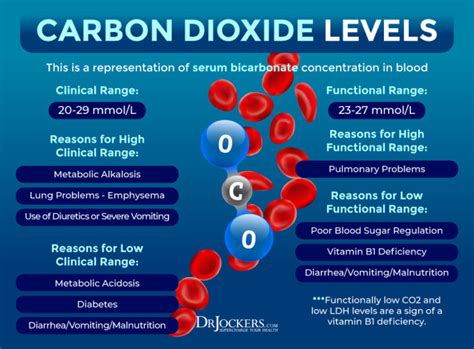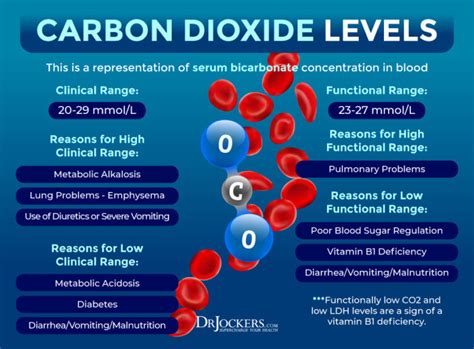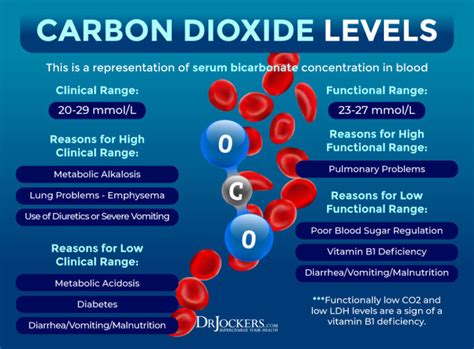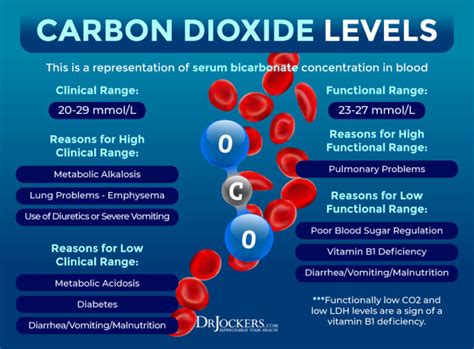Intro
Discover the causes and effects of low carbon dioxide blood levels, also known as respiratory alkalosis, and learn how to manage hypocapnia, a condition characterized by reduced CO2 levels, through proper diagnosis and treatment.
Low carbon dioxide blood levels, also known as respiratory alkalosis, occur when the body has an insufficient amount of carbon dioxide in the blood. This condition can be caused by various factors, including hyperventilation, high-altitude environments, and certain medical conditions. Understanding the importance of maintaining proper carbon dioxide levels in the blood is crucial, as it plays a significant role in regulating the body's acid-base balance. In this article, we will delve into the world of low carbon dioxide blood levels, exploring their causes, symptoms, and treatment options.
The human body relies on a delicate balance of oxygen and carbon dioxide to function properly. When we breathe in, oxygen enters the lungs and is transported to the body's tissues, where it is used to produce energy. At the same time, carbon dioxide, a byproduct of energy production, is transported back to the lungs and exhaled out of the body. This process is essential for maintaining proper pH levels in the blood, as carbon dioxide helps to regulate the body's acid-base balance. Low carbon dioxide blood levels can disrupt this balance, leading to a range of symptoms and potentially serious health complications.
Low carbon dioxide blood levels can be caused by a variety of factors, including hyperventilation, high-altitude environments, and certain medical conditions. Hyperventilation, which is characterized by rapid and deep breathing, can lead to an excessive elimination of carbon dioxide from the blood. This can occur in response to stress, anxiety, or other emotional stimuli. High-altitude environments, where the air pressure is lower, can also cause low carbon dioxide blood levels, as the body adapts to the lower oxygen levels by increasing breathing rate and depth. Certain medical conditions, such as asthma, chronic obstructive pulmonary disease (COPD), and pneumonia, can also lead to low carbon dioxide blood levels, as they can affect the lungs' ability to regulate gas exchange.
Causes of Low Carbon Dioxide Blood Levels

Respiratory Factors
Respiratory factors are the most common causes of low carbon dioxide blood levels. Hyperventilation, which is characterized by rapid and deep breathing, can lead to an excessive elimination of carbon dioxide from the blood. High-altitude environments, where the air pressure is lower, can also cause low carbon dioxide blood levels, as the body adapts to the lower oxygen levels by increasing breathing rate and depth. Lung diseases, such as asthma, COPD, and pneumonia, can also lead to low carbon dioxide blood levels, as they can affect the lungs' ability to regulate gas exchange.Symptoms of Low Carbon Dioxide Blood Levels

Treatment Options
Treatment options for low carbon dioxide blood levels depend on the underlying cause and severity of the condition. In mild cases, treatment may involve breathing exercises and relaxation techniques to help manage stress and anxiety. In more severe cases, treatment may involve oxygen therapy, medication, and hospitalization. Oxygen therapy can help increase oxygen levels in the blood, while medication can help manage symptoms such as anxiety and panic. Hospitalization may be necessary in severe cases, where patients can receive close monitoring and treatment.Diagnosis of Low Carbon Dioxide Blood Levels

Blood Gas Analysis
Blood gas analysis is a laboratory test that measures the levels of oxygen, carbon dioxide, and other gases in the blood. This test can help diagnose low carbon dioxide blood levels and identify the underlying cause of the condition. Blood gas analysis can also help monitor the effectiveness of treatment and adjust therapy as needed.Complications of Low Carbon Dioxide Blood Levels

Prevention
Prevention of low carbon dioxide blood levels involves managing underlying conditions and avoiding triggers that can lead to hyperventilation and respiratory alkalosis. This may include stress management techniques, such as meditation and deep breathing exercises, as well as avoiding high-altitude environments and lung irritants. Regular exercise and a healthy diet can also help maintain overall health and reduce the risk of complications.Management of Low Carbon Dioxide Blood Levels

Lifestyle Modifications
Lifestyle modifications play a critical role in managing low carbon dioxide blood levels. Stress management techniques, such as meditation and deep breathing exercises, can help reduce stress and anxiety and prevent hyperventilation. Regular exercise can help maintain overall health and reduce the risk of complications, while a healthy diet can help maintain proper nutrient levels and support overall health.Conclusion and Final Thoughts

We invite you to share your thoughts and experiences with low carbon dioxide blood levels in the comments section below. Have you or someone you know been diagnosed with this condition? What treatment options have you found most effective? Share your story and help others understand the importance of managing low carbon dioxide blood levels.
What are the symptoms of low carbon dioxide blood levels?
+The symptoms of low carbon dioxide blood levels can vary depending on the underlying cause and severity of the condition, but common symptoms include dizziness, lightheadedness, and fainting, as well as numbness or tingling in the hands and feet.
How is low carbon dioxide blood levels diagnosed?
+Diagnosis of low carbon dioxide blood levels typically involves a physical examination, medical history, and laboratory tests, such as blood gas analysis and electrocardiogram (ECG).
What are the treatment options for low carbon dioxide blood levels?
+Treatment options for low carbon dioxide blood levels depend on the underlying cause and severity of the condition, but may include oxygen therapy, medication, and hospitalization, as well as lifestyle modifications, such as stress management techniques and breathing exercises.
